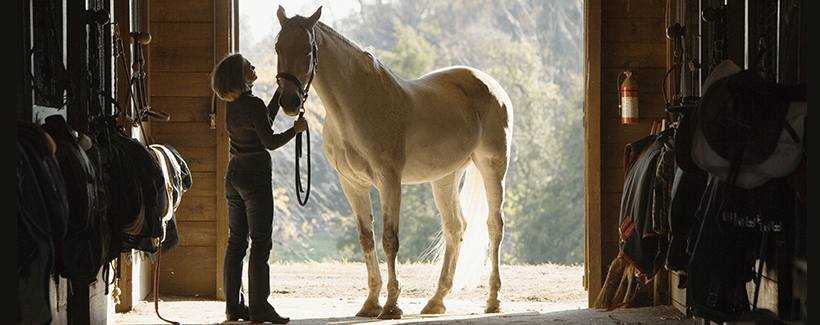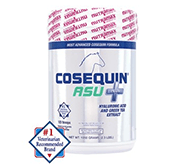Serving you since 1994
Serving you since 1994


Learn about internal parasites in horses »
“Proper management entails not putting too many horses on too little land, rotating pastures if possible, and removing feces regularly.”
Provides safe, broad-range parasite control, including tapeworms and bots.

Joint supplement contains glucosamine and chondroitin, plus hyaluronic acid (HA) and Green Tea Extract.
A horse's digestive system is made to process large quantities of grass, which is high in fiber and water. The basic diet for most horses should be grass and good quality hay, free of dust and mold. In most cases, plenty of fresh, clean, unfrozen water should be available at all times, even if the horse only drinks once or twice a day.
Most of the time, horses should be able to graze or eat hay when they want to. An empty stomach lends itself to a higher risk of ulcers, which are quite common in race and sport horses. How much to feed depends on various factors such as condition and activity level, but most horses should eat between 2% and 4% of their body weight in pounds of hay or other feeds. You have to watch your horse and make sure he is maintaining an appropriate weight. Your veterinarian can help you decide how to feed to keep your horse fit and healthy.
Most horses, even fairly active ones, don't need the extra calories found in grains, which are high in carbohydrates. Foals fed "high energy" diets can develop bone and joint problems. Some adult horses develop certain muscle disorders related to excess carbohydrates. It is also incorrect to feed a horse extra grain in the winter to keep him warm. Hay, in fact, produces more heat when digested.
Related Article: Leading Your Horse
Any changes in the diet should be made gradually to avoid colic (abdominal pain usually associated with intestinal disease) or laminitis (painful inflammation in the hoof associated with separation of the hoof bone from the hoof wall), either of which can be catastrophic. A horse or pony breaking into the grain bin or being allowed to gorge on green pasture for the first time since the fall is headed for disaster. If you travel with your horse, bring his food along. For some horses, you may also have to bring a supply of the water he is used to.
Save now on horse supplies and equipment »
All horses need vaccinations and most need regular deworming. The specifics should be discussed with an equine veterinarian. Every horse should be protected against tetanus. Other vaccines given routinely include eastern and western equine encephalomyelitis, equine influenza, rhino pneumonitis (equine herpes), and rabies. Vaccines for West Nile Virus are also available. Ask your veterinarian if other vaccines are appropriate for your horse.
Worms can cause weight loss, poor coat, and colic, which can be deadly. It is best to have your veterinarian test and deworm your horse, or advise you on what to use and when. More important than treating worms is minimizing the horse's exposure to parasites. Proper management entails not putting too many horses on too little land, rotating pastures if possible, and removing feces regularly.
Contrary to what you may have heard, straight stalls are not necessarily worse than box stalls if the horses are together, and spend most of their day outside. Horses isolated in box stalls can develop behavioral problems from lack of companionship, exercise, and mental stimulation. Whenever possible, horses should be outside with other horses every day.
Horses can go into a light sleep with their legs "locked" so that it takes very little effort to remain standing. In order to achieve deep (REM or "dreaming") sleep, a horse must lie flat. It is not known how much or how often a horse needs to do this, but do take note of any changes in your horse's sleeping patterns.
Horses were born to move. In the wild they may walk many miles in a day, sometimes trot, but rarely gallop unless they have to. Daily opportunity to exercise is a must, but if you are building up your horse's strength and conditioning, follow a sensible plan and do it gradually.
Hooves should be trimmed every six to eight weeks for horses whose feet do not get adequate natural wear. Despite tradition, most horses don't need shoes if their hooves are given the opportunity to strengthen naturally. In fact, some hoof problems are directly related to shoeing. However, changes should not be made suddenly or without expert guidance. Finding a veterinarian or farrier willing to discuss all the options may be hard, but worthwhile. In any case, neglecting the feet can be disastrous for the horse.
Unless it is very wet and windy, horses tolerate cold much better than heat and humidity. If they can't sweat, they can't get rid of heat buildup in their bodies. If the sum of the temperature in degrees Fahrenheit and the relative humidity in percentage is over 130, you should be cautious about exercising your horse. If it is over 150, you should probably rest in the shade, and if it is over 180, most horses should not work at all.
The veterinarians at the ASPCA Animal Poison Control Center have compiled the following list of spring and summer hazards for horses:
0 of 3 items selected